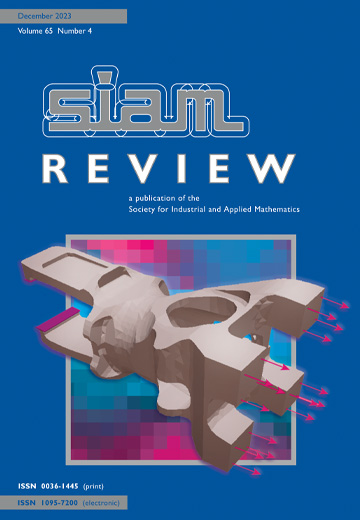尊重对流扩散方程离散最大原则的有限元方法
IF 6.1
1区 数学
Q1 MATHEMATICS, APPLIED
引用次数: 0
摘要
SIAM Review》,第 66 卷,第 1 期,第 3-88 页,2024 年 2 月。 对流-扩散-反应方程是标量守恒的模型。从分析的角度看,这些方程的解在某些条件下满足最大值原则,这些原则代表了解的物理边界。在实际应用中,数值近似解是否遵守同样的界限往往至关重要。这一特性的数学表述称为离散最大值原理(DMP),它有助于提高方法的物理一致性。在许多应用中,对流在几个数量级上主导着扩散。众所周知,在这种对流主导的情况下,标准离散法通常不满足 DMP。事实上,在这种情况下,如何构建一方面尊重 DMP,另一方面又能计算出精确解的离散方法是一个极具挑战性的问题。本文介绍了满足局部或全局 DMP 的有限元方法,主要关注对流主导机制。本文讨论了基本数值分析的概念。调查显示,对于稳态问题,只有少数几种离散方法(均为非线性方法)既能满足 DMP,又能计算出相当精确的解,例如代数稳定方案。而且,这些离散化方法大多是近几年开发的,显示了近来取得的巨大进步。同样,基于代数稳定的方法(包括非线性和线性方法)是目前唯一一种既能满足全局 DMP 要求,又能在对流主导情况下获得演化方程精确数值结果的有限元方法。本文章由计算机程序翻译,如有差异,请以英文原文为准。
Finite Element Methods Respecting the Discrete Maximum Principle for Convection-Diffusion Equations
SIAM Review, Volume 66, Issue 1, Page 3-88, February 2024.
Convection-diffusion-reaction equations model the conservation of scalar quantities. From the analytic point of view, solutions of these equations satisfy, under certain conditions, maximum principles, which represent physical bounds of the solution. That the same bounds are respected by numerical approximations of the solution is often of utmost importance in practice. The mathematical formulation of this property, which contributes to the physical consistency of a method, is called the discrete maximum principle (DMP). In many applications, convection dominates diffusion by several orders of magnitude. It is well known that standard discretizations typically do not satisfy the DMP in this convection-dominated regime. In fact, in this case it turns out to be a challenging problem to construct discretizations that, on the one hand, respect the DMP and, on the other hand, compute accurate solutions. This paper presents a survey on finite element methods, with the main focus on the convection-dominated regime, that satisfy a local or a global DMP. The concepts of the underlying numerical analysis are discussed. The survey reveals that for the steady-state problem there are only a few discretizations, all of them nonlinear, that at the same time both satisfy the DMP and compute reasonably accurate solutions, e.g., algebraically stabilized schemes. Moreover, most of these discretizations have been developed in recent years, showing the enormous progress that has been achieved lately. Similarly, methods based on algebraic stabilization, both nonlinear and linear, are currently the only finite element methods that combine the satisfaction of the global DMP and accurate numerical results for the evolutionary equations in the convection-dominated scenario.
Convection-diffusion-reaction equations model the conservation of scalar quantities. From the analytic point of view, solutions of these equations satisfy, under certain conditions, maximum principles, which represent physical bounds of the solution. That the same bounds are respected by numerical approximations of the solution is often of utmost importance in practice. The mathematical formulation of this property, which contributes to the physical consistency of a method, is called the discrete maximum principle (DMP). In many applications, convection dominates diffusion by several orders of magnitude. It is well known that standard discretizations typically do not satisfy the DMP in this convection-dominated regime. In fact, in this case it turns out to be a challenging problem to construct discretizations that, on the one hand, respect the DMP and, on the other hand, compute accurate solutions. This paper presents a survey on finite element methods, with the main focus on the convection-dominated regime, that satisfy a local or a global DMP. The concepts of the underlying numerical analysis are discussed. The survey reveals that for the steady-state problem there are only a few discretizations, all of them nonlinear, that at the same time both satisfy the DMP and compute reasonably accurate solutions, e.g., algebraically stabilized schemes. Moreover, most of these discretizations have been developed in recent years, showing the enormous progress that has been achieved lately. Similarly, methods based on algebraic stabilization, both nonlinear and linear, are currently the only finite element methods that combine the satisfaction of the global DMP and accurate numerical results for the evolutionary equations in the convection-dominated scenario.
求助全文
通过发布文献求助,成功后即可免费获取论文全文。
去求助
来源期刊

SIAM Review
数学-应用数学
CiteScore
16.90
自引率
0.00%
发文量
50
期刊介绍:
Survey and Review feature papers that provide an integrative and current viewpoint on important topics in applied or computational mathematics and scientific computing. These papers aim to offer a comprehensive perspective on the subject matter.
Research Spotlights publish concise research papers in applied and computational mathematics that are of interest to a wide range of readers in SIAM Review. The papers in this section present innovative ideas that are clearly explained and motivated. They stand out from regular publications in specific SIAM journals due to their accessibility and potential for widespread and long-lasting influence.
 求助内容:
求助内容: 应助结果提醒方式:
应助结果提醒方式:


